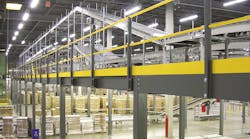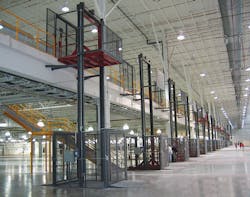One of the biggest challenges currently facing warehouses and distribution centers (DCs) in the U.S. is time. Facilities across the country are under an increasing amount of pressure to get products out the door and into the hands of consumers more quickly. While this dramatic uptick in demand yields positive results for the bottom line, operations managers tasked with smoothly moving these large product volumes through their facilities find themselves struggling to successfully keep pace. In an effort to meet these demands and keep operational costs low, an increasing number of companies are turning to facility automation to ensure accurate and timely product delivery.
A cursory Internet search for warehouse automation equipment is sure to leave the most organized and pragmatic mind reeling with information overload. In addition to an abundance of product specifications, the highly customizable nature of this equipment adds an exponential number of factors to consider before a final decision can be made. And while consumers can find automation products that resolve their immediate needs, many question the ability of the selected equipment to meet their facility’s long-term growth plans. With all these variables to consider, where does a company just starting out on their automation journey begin?
One place to start is with an investment in mezzanines and vertical reciprocating conveyors (VRCs). These two material handling solutions are foundational pieces of equipment in the automation process.
WHAT IS AN INDUSTRIAL MEZZANINE?
An industrial mezzanine is an elevated floor system that can be installed between the floor and the ceiling in a warehouse or DC. Sometimes referred to as a “work platform,” these heavy-duty structures are typically constructed with steel. Capable of safely supporting tremendous loads, these structures provide facilities with a location for extra storage, manufacturing, or office space. When engineered with a nut-and-bolt design, an industrial mezzanine can be expanded or relocated (as needed) to meet a growing company’s needs.
One of the primary advantages of incorporating a mezzanine into a facility’s layout is the amount of time and money that can be saved when a company reaches their facility’s maximum capacity. While most companies that reach this point believe that their only viable solution is to move or renovate, an industrial mezzanine offers an alternative that can help extend a facility’s lifespan.
The exact specifications that a company selects for their mezzanine will dictate the amount of installation time needed. However, most can be installed within a matter of a few weeks, resulting in minimal disruption to a facility’s daily activities. Mezzanines can be incorporated into a facility’s layout at any point in time, and in some instances can be erected around ongoing operations.
HOW DO MEZZANINES FACILITATE AUTOMATION?
Industrial mezzanines can (literally) function as the foundation upon which a company’s automation equipment is housed. Constructed with heavy-duty steel, these industrial work platforms are capable of supporting the weight of automation solutions (conveyors, chutes, pick modules, etc.). With the automation process safely situated on top of a mezzanine, a facility’s precious ground level space is left available for more time-sensitive functions (i.e., receiving and dispatching products).
Depending upon the facility’s ceiling height, an industrial mezzanine can be single or multi-tiered, effectively adding a second or third level to an existing building. With the additional square footage that these work platforms afford, a company’s automation operations can be effectively scaled-up to accommodate higher product volumes. By containing the automation process to the overhead space, a physical barrier is established that prevents non-authorized personnel from accessing the often sensitive and fast-moving automation equipment. All these factors combined help ensure more accurate and timelier product delivery.
WHAT IS A VRC?
A vertical reciprocating conveyor (VRC) is a type of lifting device that safely raises and lowers materials between differing points of elevation in a warehouse or DC. Primarily comprised of guide columns, a carriage and a mechanical or hydraulic actuating mechanism, these devices can provide access to and from mezzanines, catwalks, or other existing levels within a facility. VRCs can be designed to move products and materials of all shapes and sizes. Their highly customizable nature ensures secure transportation for a company’s widest and most unwieldy loads.
Since VRCs are designed to move only cargo within a warehouse or DC, they are specifically exempt from applicable elevator codes. Instead, they are governed by their own code from the American Society of Mechanical Engineers (ASME B20.1) In essence, this means that VRCs are not held to the exacting safety standards that have been put into place to protect human cargo that is using an elevator. The ASME code allows for a greater range of flexibility when it comes to determining installation specifications, lifting speeds and applicable safety features. All of this translates to faster speeds and increased cycle rates for warehouses and DCs that choose to automate their transportation procedures. Additionally, the flexibility of the installation requirements means that VRCs can be installed for much less than the cost of an elevator.
HOW DO VRC’S SUPPORT AUTOMATION?
When moving products and materials to differing points of elevation, warehouses and DCs have traditionally relied on ladders, stairs and forklifts. While these manual forms of product transportation have been and will continue to be an essential component of the material handling landscape, automated lifting devices offer a safe and efficient alternative with which these types of tasks can be completed. For instance, when integrated with a mezzanine, a VRC offer a safe method for transporting a palletized load to a facility’s second level.
With carriages designed to accommodate a company’s exact specifications, VRCs take up a relatively small amount of space when compared to other forms of product transportation. This can benefit a facility’s overall floorplan by maximizing the available square footage. Additionally, VRCs are traditionally installed near key product storage and transportation points. This reduces the number of times a product is handled, allowing employees to concentrate on more critical operational activities.
WHY SHOULD A FACILITY CHOOSE AUTOMATION?
Automating a warehouse or DC offers a number of tangible benefits for both company and consumer. Beyond increasing a company’s product throughput, automation can help reduce a facility’s total number of costly human errors. Additionally, the automation of repetitive and redundant processes allows facilities to focus their manpower on more critical and time-sensitive activities. Companies that have incorporated automation equipment into their facilities have also reported a substantial decline in the amount of work-related injuries that occur on their premise. All these factors combined equate to a greater cost savings for companies that have chosen to implement automation.
Industrial mezzanines and VRCs also can serve as a starting point for the future incorporation of more sophisticated automation equipment. Chutes, conveyors, sorters, scanners, etc., can all be integrated with a mezzanine or VRC. Additionally, the highly adaptable nature of both mezzanines and VRCs means that they can be modified to meet a company’s future growth needs.
Paul Mihelich is vice president of sales and marketing at Wildeck Inc., a manufacturer of material lifts, warehouse mezzanines and industrial safety gates.




